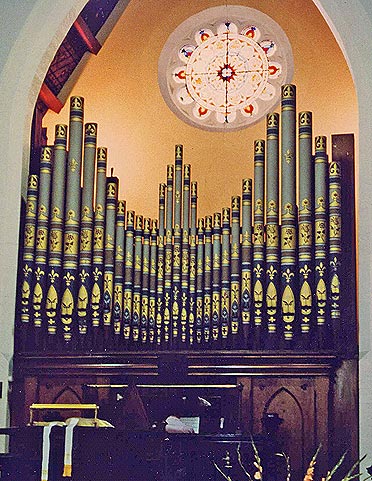Jersey Road Uniting (Congregational) Church
cnr Jersey Road & Moncur Street, Woollahra
1876 Forster & Andrews, Hull; 2m., 14 sp. st., 3c., tr.
Church and organ destroyed by fire in 1989.

Photo: KH

Photo taken after fire (Trevor Bunning)
Click on link to hear Langlais' Nasard from Suite française played by Michael Dudman. (3.3MB)
From SOJ Winter 2006:
Dr Kelvin Hastie writes:
The work of Yorkshire firm, Forster & Andrews, of Hull, is covered in detail in Graeme Rushworth's Historic Organs of New South Wales. [1] Rushworth describes the eight examples of this firm's work that were exported to New South Wales between 1876 and 1887, noting the loss through rebuilding and subsequent removal of the old University of Sydney organ of 1881 and the destruction by fire in 1961 of the 1883 instrument in the former Redfern Congregational Church. Less than a year after Rushworth's volume was published, the first Forster & Andrews organ exported to Australia - that of the Jersey Road Uniting Church Woollahra, dating from 1876 - was reduced to ash and lumps of metal in an arson attack on 27 January 1989.
The Jersey Road organ was built at a cost of £500 and opened on 1 October 1877, its design being based “on the advice of E.J. Hopkins”, of the Temple Church, London. [2] The instrument was erected in the church by Charles J. Jackson, who also made the wooden pipes for the Pedal Violon 16' and Great Bourdon 16', as well as the lower sections of the case. [3] The only known recording of the organ was made by Michael Dudman for the ABC-FM series “Historic Organs of Sydney” and since re-released in CD format under the Walsingham label.
On 30 September 1980, John Stiller, Research Officer of the Organ Historical Trust of Australia, carried out a standard documentation of the organ, noting that the only changes made to the organ were the fitting of tuning slides to open metal pipes of the Great, the replacement of the hitch-down swell pedal by a balanced pedal and the removal of the hand-blowing apparatus. [4] He noted the following characteristics of the instrument:
1. The original sound of the organ has been retained, having a rather dark and restrained quality which seems to be a feature of many organs built by Forster & Andrews.
2. All of the original pipework is still present, and the Great Stopped Diapason 8 ft. is unusual for Forster & Andrews [partially constructed of stopped metal] and may well be unique in their Australian instruments.
3. The open metal pipework on the Swell retains its cone tuning.
4. The case design is very typical of Forster & Andrews, containing no casework above impost level. The original ornate decorations on the display pipes have been preserved.
5. The original console is still present, which includes the unusual feature of sloping stop jambs. Original console fittings still present include stopknobs, stop labels, keyboards, keyboard cheeks, pedalboard and composition pedals.
6. The original mechanical key, stop and combination actions have been preserved, and the Great key action contains the unusual feature of a double-sided roller board. [5]
The specification of the organ was:
| GREAT Bourdon Open Diapason Stopped Diapason Dulciana Principal Flute Twelfth Fifteenth SWELL Open Diapason Flute d'Amour Principal Oboe Tremulant PEDALS Violon Bourdon COUPLERS Swell to Great Great to Pedals Swell to Pedals |
16 ft. Tone 8 ft. 8 ft. 8 ft. 4 ft. 4 ft. 2-2/3 ft. 2 ft. 8 ft. 8 ft. 4 ft. 8 ft. 16 ft. 16 ft. |
56 pipes 56 “ 56 “ 56 “ 56 “ 56 “ 56 “ 56 “ 56 “ 56 “ 56 “ 56 “ [knob under keydesk] 30 “ 30 “ |
Total number of pipes = 732
Pitch a1 = 441.6 Hz at 23 degrees
Following the fire, the Uniting Church, which owned several other buildings in close proximity, thereby rendering re-occupation at Jersey Road unviable, decided to sell the site and the shell of the building was then restored and converted to a suite of upmarket apartments by a property developer.
[1] Graeme D. Rushworth, Historic Organs of New South Wales: the instruments, their makers and players 1791-1940 (Sydney: Hale & Iremonger, 1988), 239-51.
[2] The organ is described in The New South Wales' Independent, 15 March 1877, page 42.
[3] Rushworth, page 242.
[4] John Stiller, “Uniting Church Jersey Road Woollahra NSW - Documentation of Pipe Organ built by Forster & Andrews 1876”. Organ Historical Trust of Australia, 30 September 1980.
[5] Ibid.